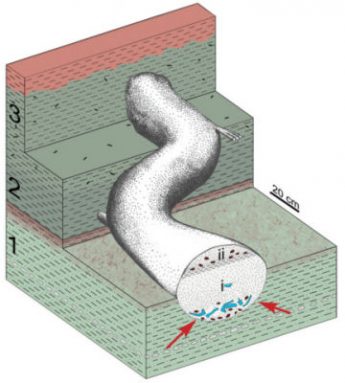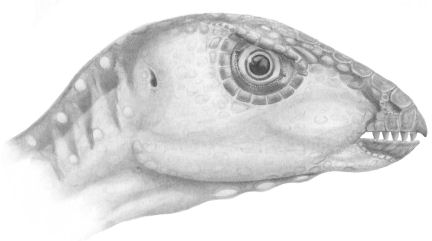Digging Dinos
Scientists have discovered a new dinosaur species that spent time underground.
By Emily Sohn
Dinosaurs didn’t just roam the Earth’s surface during their reign on the planet tens of millions of years ago. New evidence suggests that some dinos also spent time underground.
Paleontologists from Montana State University in Bozeman made the discovery. They were searching through 95-million-year-old layers of rock in southwestern Montana when they came across an unusual patch of sandstone. The material was sticking out of surrounding rocks.
 |
|
Scientists found the new dino’s remains in an S-shaped mass of sandstone, shown here, which represents the size and shape of an ancient burrow. |
| L. Hall/Montana State University |
Inside the sandstone, the scientists found a mass of small bones packed tightly together. Further investigation revealed that the bones came from one adult dinosaur and two young dinos. All three belonged to a previously undiscovered species.
The researchers suspect that the sandstone mass shows where a tunnel used to be. At some point long ago, a flood of sand suddenly filled the burrow, trapping and killing dinosaurs that were living inside. That material later hardened into sandstone.
The piece of sandstone that filled the tunnel was shaped like the letter S. It was about 2.1 meters (7 feet) long. For most of the tunnel’s length, the stone measured about 30 centimeters (12 inches) wide and 45 cm (18 inches) tall. At the end of the tunnel, where the bones were found, the sandstone mass was about 45 cm (18 inches) wide.
The scientists don’t think the doomed dinos were dragged into the burrow by a predator. One reason is that the skeletons were missing very few bones. Also, there were no bite marks on the bones.
 |
|
This is an illustration of Oryctodromeus cubicularis, a newly discovered dinosaur that burrowed underground. |
| L. Hall/Montana State University |
Members of the newly discovered species were slim. Adults were probably about 2.1 meters (7 feet) long, but a 1.25-m (4-foot)-long tail made up most of that length. A fully grown member of the species would have come up to the knees of a human adult.
Among other bone-based clues, the shape of the dinosaur’s forearms shows where strong digging muscles could have been. And wide hips suggest that the creature could have braced itself while burrowing.
The new fossil find is the best evidence yet that some dinosaurs dug burrows and lived in dens, the researchers say. The young skeletons were nearly two-thirds the size of the adult. That supports a theory that some dinos took care of their young. The find also suggests that digging dinos could have been more common than paleontologists previously thought.
The researchers have named the new species Oryctodromeus cubicularis. In Greek, the name means “digging runner of the lair.”—Emily Sohn
Going Deeper:
Perkins, Sid. 2007. Digging the scene: Dinos burrowed, built dens. Science News 172(Oct. 27):259. Available at http://www.sciencenews.org/articles/20071027/fob1.asp .







